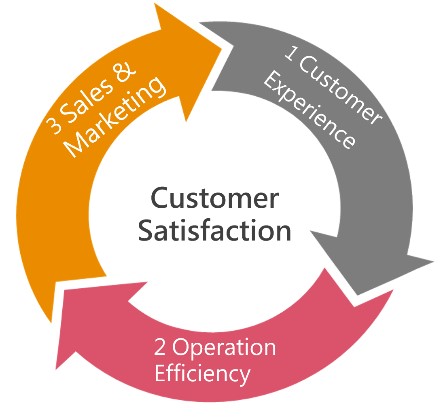Economy & Business
Hushan's global success story
How does a Taiwan-based aftermarket car handle manufacturer win the global market?
Courtesy of PwC
I. Organization Background
Hushan Autoparts Inc. was established in 1972 and is the leading manufacturer in the automotive door handle aftermarket. Based in Taiwan, the company exports approximately ten million door handles annually, exporting to more than 500 customers in over 100 countries, with a global market share of over 50. Its primary products include aftermarket automotive handles, cameras, parking sensors, fasteners, and door components.
To find new growth opportunities, Hushan began developing electronic car products such as cameras and sensors in 2018. Hushan later became the first company whose camera/parking sensor products were certified by the American CAPA (Certified Automotive Parts Association). In addition to its existing brand, Hushan has also launched camera and sensor brands for international markets.

YC Chen, CEO of Hushan
II. Impetus for Digital Transformation

Hushan faced a number of challenges. First, fragmentation of the car parts aftermarket caused delayed deliveries. Hushan must improve inventory and supply chain operation to reduce lead times.
Second, Hushan faces competition from low-cost manufacturers in developing countries like China, Thailand, and India, which led to reduced profits and lower market share. Hushan must adopt strategies to surpass its competitors in quality and cost to maintain competitiveness.
Third, Hushan must seek out new opportunities for growth due to slow growth in the existing market. Hushan's revenue has remained flat since 2017, requiring the company to seek new growth opportunities. To remain successful, Hushan must stay attuned to customers’ needs and develop new sales and distribution channels.
III. Solutions
Hushan has leveraged government programs to help it implement digital transformation, including Manufacturing Industry Digital Transformation Program, Supply Chain AI Application Program, and International Market Development Program. The board of directors approved the company’s digital transformation plan in 2021 and implementation began the same year. Over the course of two years and by leveraging government programs, Hushan’s operational structure was refined. The company’s existing, newly introduced, and future systems are as follows.
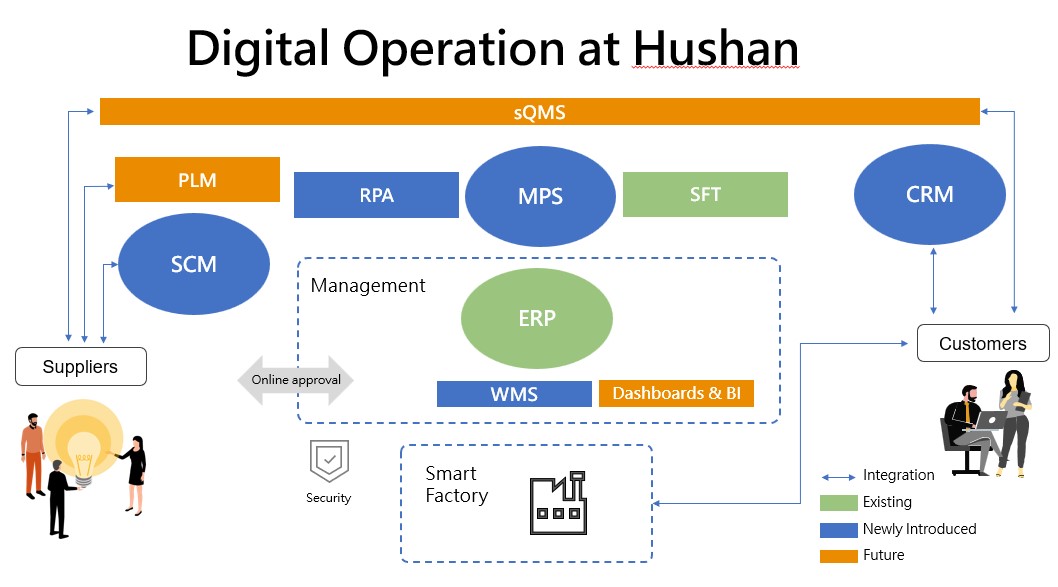
1. Existing Systems:
- Enterprise Resource Planning (ERP): Hushan first implemented an ERP to improve operational efficiency and integrate its business processes.
- Shop Floor Tracking (SFT): Hushan adopted SFT to monitor the manufacturing process, enhancing production efficiency and ensuring quality.
2. Newly Introduced Systems:
- Supply Chain Management (SCM): An SCM was implemented to optimize supply chain processes, enhancing inventory management and supply chain efficiency.
- Master Production Scheduling (MPS): The introduction of MPS has helped with detailed production scheduling, improving production efficiency.
- Warehouse Management System (WMS): The implementation of a WMS has improved inventory management and warehouse operations efficiency.
3. Future Systems:
- Product Lifecycle Management (PLM): There are plans to introduce a PLM to better manage the product lifecycle, including the design and production stages.
- Smart Quality Management System (sQMS): The introduction of an sQMS will help improve product quality and monitor quality-related data.
- Dashboards: The implementation of dashboards combined with Business Intelligence (BI) analytics will allow for better data analysis and informed decision-making.
- Smart Factory: By leveraging AI and IoT technologies, Hushan aims to advance its factory automation and improve data-sharing with customers, thereby increasing efficiency and customer satisfaction.
The use of these systems will help Hushan shorten lead times, enhance efficiency, and improve cost competitiveness.
Using ERP and SCM to improve inventory management and reduce lead times
ERP is a system that integrates operational activities such as procurement, production, and accounting. SCM is used to manage supply chain operations, processes, and scheduling. After introducing ERP in 2012, Hushan began optimization of the system in 2018, and then implemented a SCM to integrate operational information. These innovations improved process management and operation efficiency.
1. Enhancing operational efficiency through the ERP system's built-in standardized processes
- Standardization of inventory management: Hushan standardized coding for most materials and products and systematically categorized and managed its inventory of over 10,000 items. Hushan employed ERP to keep track of real-time inventory, including quantity, location, and expiration date, and utilized the system to generate standardized data reports, allowing managers to decide whether to make purchases, ensuring sufficient inventory and avoiding excess stock.
- Standardization of order entry procedures: The original ERP system required sales staff to manually input data when creating orders. The optimized ERP system allows direct import of files and standardizes different formats of data, such as PDF and Excel, for batch inputs, reducing order creation time between 30% to 50%. This not only reduces errors in manually created orders but also increases operational efficiency.
- Standardization of shipment notifications: Due to unfamiliarity with work schedules across its markets, Hushan sales staff were unable to keep track of shipping notifications, leading to customer dissatisfaction. Hushan used the ERP system to automatically generate shipping notifications, which include detailed information about the shipment, including product name, quantity, shipping date, and destination. The automatic notifications improved operational efficiency and improved the customer experience.
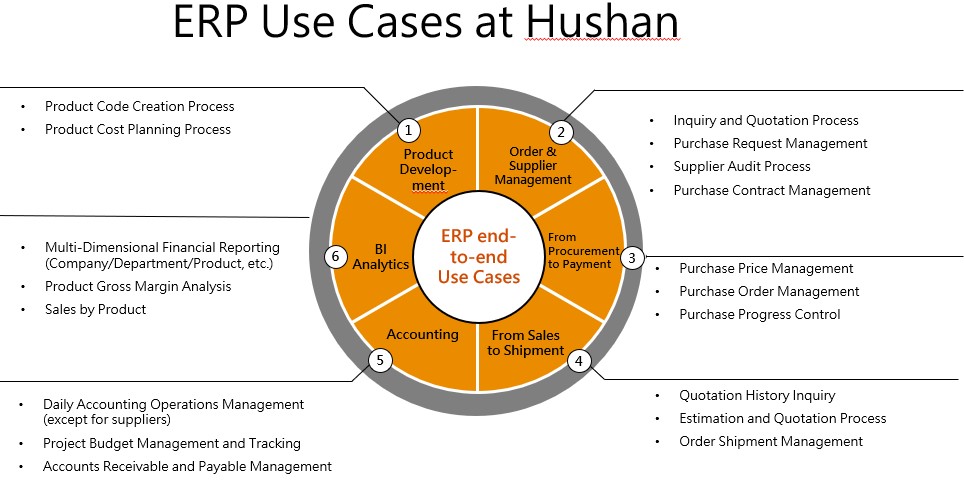
Through initial process standardization and system integrations, Hushan can now combine vendor history inquiries, procurement, sales, finance, and other common business functions, streamlining daily operational management.
2. Introduction of a SCM system, improving supply chain efficiency, and shortening lead times
To help upstream supply chain manufacturers manage operations, Hushan introduced the Supply Chain Management system (SCM) allowing suppliers to automatically receive system-processed procurement information without manually compiling each piece of data individually.
After Hushan evaluates and confirms the purchase, the ERP will transfer the purchase order data to SCM, and the system will automatically notify the supplier. The supplier can then respond to the lead times in the system and will be automatically reminded of unfulfilled orders. This saves procurement staff time on correspondence with the supplier to confirm and track progress and reduces the likelihood of errors compared to manual order entry. After systemizing supply chain operation processes, the cost and errors associated with back-and-forth communication are removed.
To create a more efficient supply chain, Hushan offered incentives to motivate suppliers to go digital. Many of Hushan’s suppliers are small and medium-sized companies with different degrees of digitalization. Hushan agreed to vendors' requests for price increases and shortened payment terms to encourage use of the supply chain management system and electronic invoicing. Hushan’s procurement department assisted and trained employees of its suppliers, deepening relationships in its supply chain. Currently, 50 suppliers have joined the SCM system, accounting for 80% of Hushan’s supply chain. Hushan’s supply chain activities are therefore managed and coordinated more effectively using the SCM.
Enhanced efficiency and reduced costs through production scheduling systems and warehouse management system
The production scheduling system assesses how many products are made based on demand and materials at hand. Before implementing the master production scheduling (MPS) system, Hushan faced a number of issues, such as inefficient production planning, longer delivery cycles, and excess inventory. Automating the factory using digital systems makes the movement of goods in and out of the warehouse more transparent and efficient, helping to save on labor.
1. Establishing a production scheduling system improves operational and managerial efficiency and reduces production and inventory costs.
Hushan introduced a production scheduling system for its key processes. The MPS system not only handles production scheduling but also analyzes recent order data to forecast sales and creates daily figures on stock that is about to run out.
In contrast to the conventional monthly stock counting, Hushan's MPS system performs daily calculations. It processes data for about 5,000 items – collectively responsible for 80% of sales – and integrates the day's orders with the procurement data from the previous day. This approach ensures an up-to-date record of inventory, providing a timely and accurate basis for management decisions.
Through continuous adjustments and testing, the time it takes to run inventory records has been reduced from over ten hours to six hours. Now, the system operates overnight, and managers can make production decisions and manage shipments based on the results the following day. The adoption of MPS has brought about following benefits.
- Increased operational efficiency: Before the MPS was introduced, it took at least three to five days for the sales team to confirm inventory and report back to customers on availability. Now the sales team can see the latest inventory availability and order completion ratios every day, helping to quickly communicate delivery quantities and schedules with customers, thus increasing efficiency. When inventory is on hand, orders received at 8am can be dispatched to ship out by 4pm the same day, facilitating instant order processing and expedited delivery.
- Improved management quality and efficiency: Previously, Hushan decided on purchase quantities without a clear quantitative benchmark. By using data, Hushan has established management reports for daily, weekly, monthly, and quarterly periods to improve decision-making. This helps senior executives identify problems and propose improvements more quickly.
- Reduced inventory costs: In the past, it was often too late for the sales team to inform the production department about canceled orders, causing unnecessary waste. Now, the MPS includes new and canceled orders of the day, which management then uses to assess whether to purchase or negotiate returns with suppliers, reducing production and inventory costs.
Implementing WMS to accelerate shipping and reduces labor costs
To effectively manage inventory and save on labor costs, Hushan introduced a Warehouse Management System (WMS), which quickly and accurately records the movements of products into and out of the warehouse. This allows managers to effectively keep track of inventory and shipping.
Following the introduction of the system to optimize shipping and picking schedules, Hushan initiated warehouse picking challenges to enhance workers' speed. Consequently, the average picking time at Hushan has been halved from 6 minutes to just 3 minutes, markedly boosting the pace of dispatch while simultaneously cutting down on warehousing labor expenses.
Seizing sales opportunities and establishing direct sales channels to unlock growth
To unlock new areas of growth, it is important for Hushan to seize sales opportunities and expand its sales channels. Hushan uses digital tools to gather market intelligence, understand market trends, and uses e-commerce platforms to directly connect with customers and diversify its customer acquisition channels.
1. Market Intelligence and Consumer Engagement
Hushan had prioritized the development of a demand forecasting system to closely track market trends. Initially leveraging web crawling technology, Hushan has since transitioned to using bots that scour the internet for demand signals related to handles. By mining data from car owner communities, dealerships, forums, and other online platforms, Hushan gains a nuanced understanding of market sentiment and consumer pain points, informing both demand prediction and product innovation strategies. Currently, the data collected from e-commerce platforms has been incorporated into the demand forecasting parameters in the production scheduling system.
In addition to this, Hushan conducts a thorough analysis of global pricing to remain competitive and taps into vehicle ownership statistics to anticipate demand fluctuations across various car models. Strategic market investigation and production planning like this ensures Hushan retains a solid footing in the market.
2. Expanding New Channels through E-commerce Platforms
Leveraging both online and offline channels, auto parts sellers can offer consumers more options to fulfill their purchase requirements. In pursuit of increased brand visibility and higher market value, Hushan launched proprietary brands for camera modules and parking sensors, named iAutoeyes and Master Tailgater, for the international markets. Hushan has broadened its market presence in the U.S. and Europe by utilizing Amazon, Alibaba, and eBay e-commerce platforms.
In 2023, Hushan is preparing to launch on Shopify to expand sales channels and complete their transactions on the cloud. Shopify is a cloud-based online store platform that is linked to social media, with one main site connecting to multiple sub-sites. Merchants can choose multiple languages and currencies, customize their store pages, and bulk upload product information. Shopify allows consumers to place bulk orders. With the integration of popular delivery services like DHL and UPS, the system automatically determines shipping costs, streamlining the process for consumers to pay and finalize their orders directly online.
Shopify increases Hushan's operational efficiency and accuracy while improving the customer experience. By integrating Shopify with the ERP system, customers can see the lead times when ordering. For items not immediately available, the system provides an estimated lead time, giving customers the information needed to make informed purchasing decisions. This self-service approach not only eliminates the need for manual order entry, reducing the potential for human error, but also enhances overall transaction efficiency.
Hushan initially launched dedicated Shopify sites for the U.S., Europe, China, and Taiwan markets, carving out a direct sales channel in Taiwan to supplement its existing dealer network. Hushan anticipates utilizing Shopify's price adjustment capability to effectively clear out surplus inventory in different countries. This is expected to streamline inventory management and increase revenue.
Digital Transformation Next Steps
Hushan is ready to continue its digital transformation by taking the following actions.
- Enhancing digital infrastructure: The company is poised to implement new digital systems such as PLM, sQMS, and Business Intelligence dashboards. This will enhance its digital framework supporting smarter, more agile operations.
- Expanding e-commerce channels in emerging markets: Hushan plans to leverage e-commerce platforms to sell surplus inventory in developing markets, which will aid in broadening its global footprint. This will help to extend market reach, especially in developing markets where older models and longer vehicle lifespans are more common, facilitating inventory clearance and meeting market demand.
- Transitioning to smart factories: A suite of smart devices, including AI-powered robotic arms, automated packaging machines, shipping inspectors, and intelligent handling systems will be deployed. The automated handling system will integrate with the warehouse management system to realize a fully automated warehousing and outbound process, thereby reducing inventory turnover time.
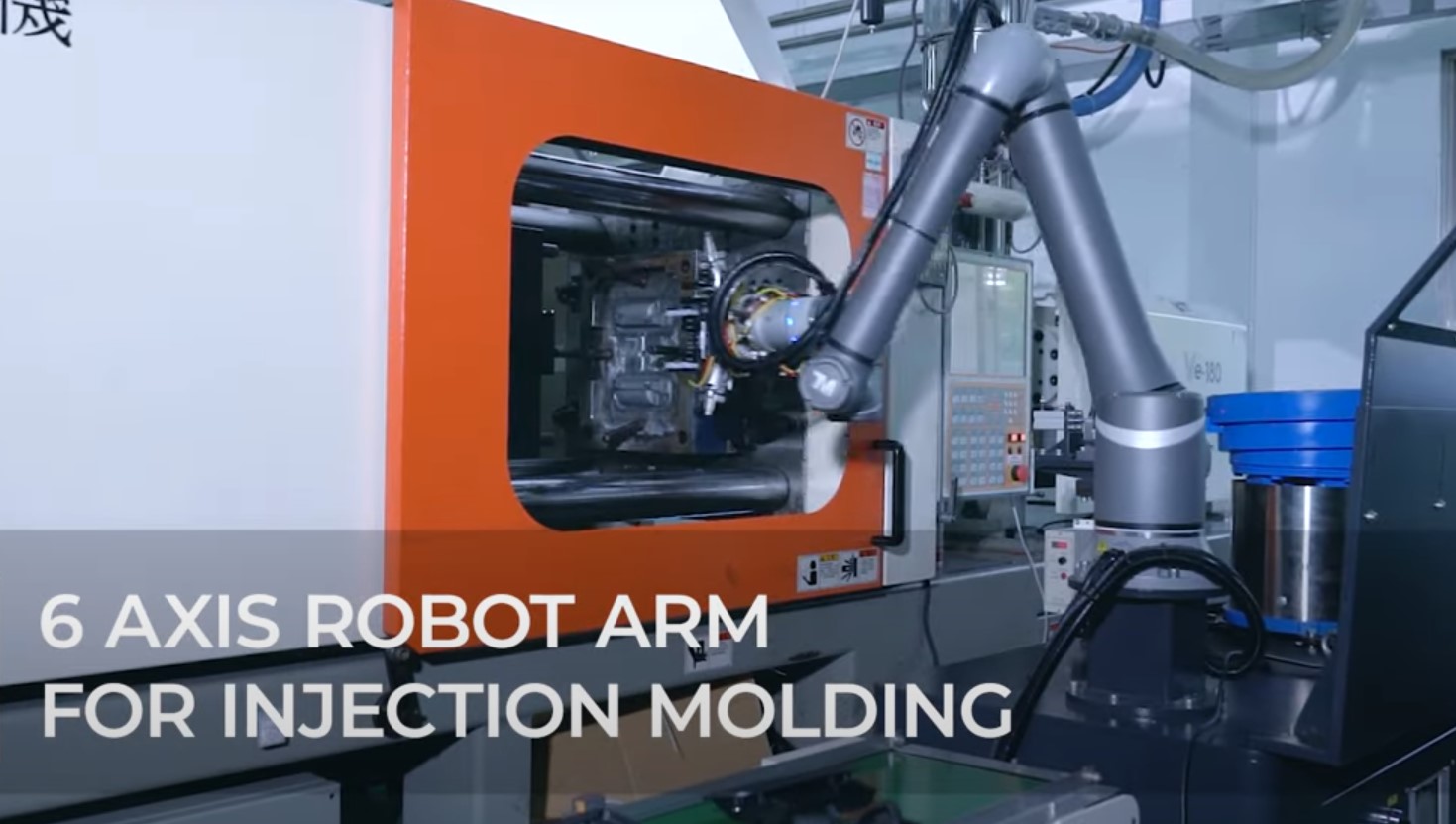
Hushan’s Automatic Robotic Arm
IV. Implementation Approaches
Hushan's digital transformation journey can be summarized as "systematization, automation, and smart operations." This approach showcases how the company employs a gradual approach to technological transformation, achieving higher efficiency and increased competitiveness. This process is divided into three stages.
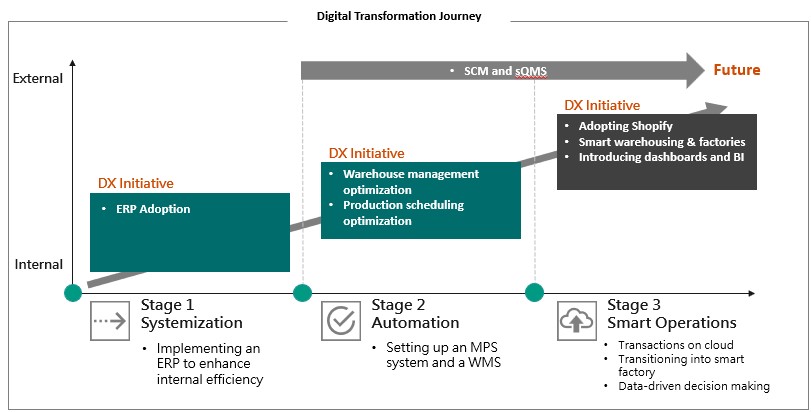
- Systemization: In the initial stage, Hushan focuses on building system functions and optimizing processes, such as implementing ERP and adding shipping notifications to the ERP system. This stage aims to reduce manual input, increase efficiency, and minimize human error. It's a practical start for small and medium-sized enterprises as it doesn't require large investment of resources and can quickly improve existing processes.
- Smart Operations: Building upon systemization and automation stages, Hushan progresses towards a higher level of transformation. This allows customers to complete their transactions on the cloud using e-commerce platforms. Other innovations include utilizing AI business analytics and applying IoT technology to realize unmanned AI smart warehousing, increasing decision-making flexibility to respond more quickly to market changes.
- Automation: Once employees are familiar with system tools, Hushan moves towards automation. This includes establishing an electronic approval system to replace traditional paper processes and introducing production scheduling and factory warehouse management systems to better coordinate business processes. This stage aims to improve the efficiency of overall operations.
V. Measurement
The benefits of Hushan's digital transformation can be measured to clearly understand the impact and outcomes of digital transformation.
- Operational Efficiency: This is a key measurement since Hushan's main goal is to increase operational efficiency and reduce costs. By speeding up business and procurement processes, existing inventory can be ordered and shipped out on the same day. The company estimates that lead times have been shortened by a third, and overall efficiency has increased by 10 to 15%.
- Talent: Since 2018 Hushan has strategically recruited senior executives with expertise in digital tools and systems to spearhead its digital transformation initiatives. Beyond hiring, Hushan is investing in upskilling its managers with training in big data and AI. This commitment to fostering digital proficiency internally is accelerating innovation and driving the success of the company’s digital transformation.
- Sales Growth: Hushan's own brand and its online and offline marketing strategies have been successful, especially in the American market. In 2022, exports to the United States increased by 33%, reflecting Hushan's proactive results in identifying new sales channels. This has built a good foundation for future growth.
- Future Growth: Hushan's digital transformation helps strengthen supply chain efficiency. By linking data across multiple systems, allowing for real-time communication and informed decisions, product yield rate is expected to increase from the current 95% to 99% over the next few years.
- Customer Satisfaction: An increase in customer satisfaction is vital for the long-term success of the company. Satisfaction among its main American customer increased from 75% to 95%, indicating high satisfaction with Hushan's services and products.
The introduction of unmanned delivery workstations will be integrated with the warehouse management system, automating inbound and outbound warehousing processes. This advancement is anticipated to decrease product lead times from over 60 to 45 days and cut inventory turnover from 200 to 160 days.
VI. Critical Success Factors
Hushan's success in digital transformation can be attributed to the following factors.
- Progressive transformation:
Hushan first introduced an ERP system and improved its existing features to begin its digital transformation journey. The total cost of setting up these initial systems was around NT$5 million (US$163,000). After setting up these key digital operations, Hushan moved to the more cost-intensive step of building a smart factory. The initial cost for creating a smart warehouse was around NT$40 million (US$1.3 million).
- Involvement of senior management and engagement of stakeholders:
The engagement of senior management played a vital role in digital transformation, ensuring that both employees and suppliers were actively involved in the process. When management endorses the transformation and is willing to put in resources, employees and suppliers are more motivated to participate and cooperate. Hushan has been successful in encouraging employees and suppliers to change their work habits and adapt to new processes, making the transformation process more successful.
- Establishment of a data-driven management and operational approach:
By integrating data from various systems and departments, Hushan ensures the integrity and consistency of the data, establishing a data-driven management and decision-making approach within the organization. Hushan’s digital transformation empowers employees to make more informed decisions. For example, the gross profit of each order is available on the ERP, better informing sales representatives’ decision making.
VII. Lessons Learned
Hushan's transformation has placed customer satisfaction at the core. The initial focus was on addressing common customer needs, such as redesigning and improving product packaging and implementing automated shipping notifications to save time for both customers and sales staff.
After enhancing the experience of existing products and services, Hushan shifted its attention to improving internal and external operational efficiency. To achieve this, Hushan integrated MPS, SCM, and WMS with the existing ERP to streamline production, shipping, and communication with suppliers, resulting in an overall enhancement of operational efficiency.
Following improvements in production efficiency and customer experience, Hushan adjusted its transformation focus to the expansion of sales channels. By placing a high priority on customer satisfaction, Hushan ensured that its digital transformation aligned with its business goals. The company involved both suppliers and customers in its digital transformation efforts, aiming for mutually beneficial outcomes for all parties involved.
